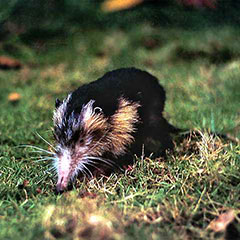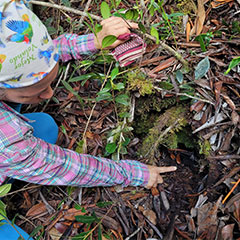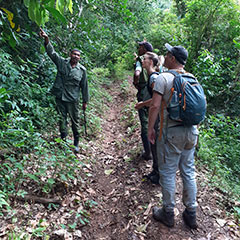
Cuban Solenodon Conservation
We’ve partnered with the IUCN SSC Small Mammal Specialist Group to study the Cuban solenodon, one of the few remaining endemic land mammals of the Caribbean, and help save it from extinction.
Protecting a Living Fossil
The Cuban solenodon, known in Cuba as the Almiquí, is one of the world’s rarest mammals and one of the more evolutionarily unique species on the planet. Along with the Hispaniolan solenodon, these “living fossils” are the only surviving members of a mammalian lineage tracing back virtually unchanged to the Cretaceous period, 145 to 66 million years ago.
Though these shrew-like mammals once existed throughout Cuba, today they are only found in the remotest southeastern regions of the island. In fact, by the 1970s, the species was believed to be extinct, as none had been documented in a long period of time. Threatened by habitat loss and introduced predators, Cuban solenodons are now considered an endangered species, and one of only 13 remaining land mammals found in the Caribbean. The insular Caribbean region has experienced the world’s highest level of mammal extinctions, with at least 29 species lost since AD 1500.
Cuban solenodons play an important role in their ecosystem. As insectivores, solenodons contribute to the balance of a healthy ecosystem by controlling populations of invertebrates.
A Steep Learning Curve
Because relatively little is known about this species, systematic studies are needed to develop a basic understanding of the solenodon’s current distribution, population, natural history, as well as what threats it may face in an ever-changing world.
Small, nocturnal, and elusive, Cuban solenodons have proven challenging to study in the wild. Dwelling in dense forests burrows at an altitude of 2,000 feet above sea level, they are extremely difficult for research teams to access. Researchers must traverse steep terrain and narrow trails while facing a lack of resources, including fuel, power and food.
Taking Action
The research team has been conducting a series of field surveys across the solenodon’s range in the Alejandro de Humboldt National Park. They're testing the feasibility and effectiveness of various detection methods, including camera traps, indirect field signs, and the use of scent dogs. The team has noted that solenodon presence can be readily identified in the field by finding characteristic signs of “nose pokes,” holes in the soil and in rotten wood made by the pointy-nosed solenodons as they hunt for their invertebrate prey. Results from these studies will improve sampling techniques and guide survey designs, which will be used to map the distribution of Cuban solenodons throughout the park.
The team is determining the most suitable sampling protocols for collecting additional data, including invasive species data, fecal sample collections, and habitat classification using aerial photos and satellite imagery. Biologists are conducting initial research into the natural history and threats to the species. Once those threats have been identified and more is known about the status of the species, a Species Action Plan will be developed to identify and propose methods to mitigate those threats.
The Team
The IUCN SSC Small Mammal Specialist Group (SMSG) is a global network of scientists and conservationists working to enable a better scientific understanding of the world’s 2,800 plus species of small mammals, and to promote the conservation of those which are most threatened.
SMSG co-chair, Dr. Ros Kennerley (based at the Durrell Wildlife Conservation Trust) and Conservation Advisor Professor Sam Turvey (based at the Zoological Society of London), bring a wealth of experience to the project, thanks to their work with the Cuban solenodon’s sister species on the island of Hispaniola. The SMSG team will provide essential skills and scientific support for Norvis Hernández Hernández, who is based at the Ministry of Sciences, Technology and Environment in Cuba. Norvis and her field team have considerable expertise in the natural history of the pristine mountains of Alejandro de Humboldt National Park in the east of the country, which is one of the two remaining strongholds for the Almiquí.
Together they have formed this project to bolster the research and conservation planning for this species. In the coming year, Zoo New England biologists from our Field Conservation Department also plan to join in field surveys for solenodons in Cuba.
About the Cuban Solenodon
Cuban solenodons are dark brown, rabbit-sized mammals with chunky bodies and short, stocky legs. They have elongated heads, small eyes, whiskers, and long, flexible snouts. Solenodons have glands in their armpits and groins that secrete a musky, goat-like odor. Although they are capable of running and climbing quickly, they have a clumsy gait and cannot jump, which leaves them vulnerable to predators.
One of the solenodon’s most unique traits is its venomous saliva, which is injected into prey through special grooves in its incisors. These teeth are the origin of the name “solenodon,” which is derived from the Greek for “grooved tooth.” The two species of solenodon are the only mammals that can, like snakes, inject venom through their teeth.
Header photo courtesy of Gerardo Begue

Cuban solenodon

Solenodon den site

Park guards point out native tree species
It’s a mouse! It’s a rat! It’s a…solenodon?
Read more about this partnership on our blog.

